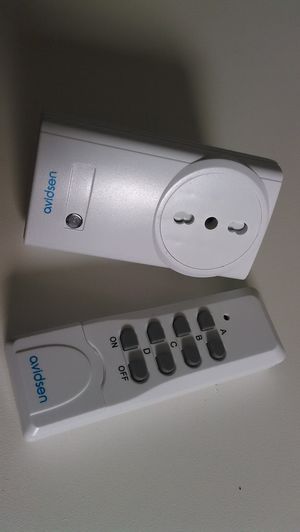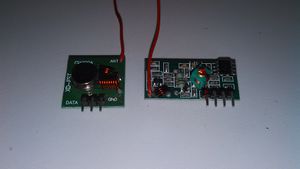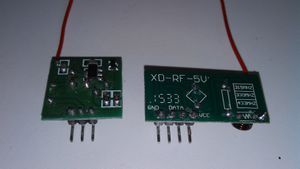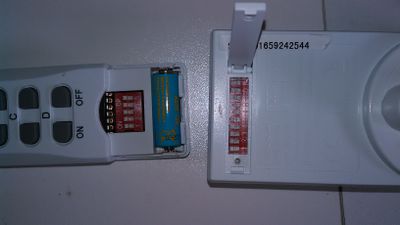Differenze tra le versioni di "Some experiments on Radio Remote Controls"
| Riga 186: | Riga 186: | ||
#define LONGDELAY 590 | #define LONGDELAY 590 | ||
#define NTIMES 12 | #define NTIMES 12 | ||
| + | #define NTIMESBF 6 | ||
unsigned int timings[MAX_CHANGES]; | unsigned int timings[MAX_CHANGES]; | ||
unsigned int changeCount; | unsigned int changeCount; | ||
| + | unsigned int verbose=0; | ||
| + | unsigned int bfvalue=0; | ||
unsigned char val(unsigned int timing) { | unsigned char val(unsigned int timing) { | ||
| Riga 208: | Riga 211: | ||
return 0; | return 0; | ||
} | } | ||
| − | Serial.print("MM53200 code: "); | + | if (verbose) Serial.print("MM53200 code: "); |
for (i=0; i<12; i++) | for (i=0; i<12; i++) | ||
Serial.print(code[i]); | Serial.print(code[i]); | ||
| Riga 219: | Riga 222: | ||
static unsigned int repeatCount; | static unsigned int repeatCount; | ||
| − | + | long time = micros(); | |
duration=time-lastTime; | duration=time-lastTime; | ||
if (duration > 5000 && duration > timings[0] - 200 && duration < timings[0] + 200) { | if (duration > 5000 && duration > timings[0] - 200 && duration < timings[0] + 200) { | ||
| Riga 227: | Riga 230: | ||
if (repeatCount == 2) { | if (repeatCount == 2) { | ||
decodeMM53200(); | decodeMM53200(); | ||
| + | #if 0 | ||
| + | for (i=0; i<changeCount; i++) { | ||
| + | Serial.print(timings[i]); | ||
| + | Serial.print(" "); | ||
| + | } | ||
| + | Serial.println(); | ||
| + | #endif | ||
repeatCount = 0; | repeatCount = 0; | ||
} | } | ||
| Riga 263: | Riga 273: | ||
} | } | ||
| − | void sendcode(int value) { | + | void sendcode(int value, int times) { |
| − | int i= | + | int i=times; |
| − | Serial.println(value, BIN); | + | if (verbose) Serial.println(value, BIN); |
while (i--) | while (i--) | ||
sendMM53200(value); | sendMM53200(value); | ||
| Riga 271: | Riga 281: | ||
void bruteforce(void) { | void bruteforce(void) { | ||
| − | + | for (; bfvalue<4096; bfvalue++) { | |
| − | for ( | + | if (Serial.available()) break; |
| − | sendcode( | + | sendcode(bfvalue,NTIMESBF); |
| + | } | ||
| + | bfvalue &= 0x3ff; | ||
} | } | ||
void inbyte(int inchar) { | void inbyte(int inchar) { | ||
| − | static value = 0; | + | static int value = 0; |
switch (inchar) { | switch (inchar) { | ||
case '\r': | case '\r': | ||
| − | sendcode(value); | + | sendcode(value,NTIMES); |
value=0; | value=0; | ||
break; | break; | ||
case 0x02: | case 0x02: | ||
| + | bfvalue=value; | ||
| + | case 0x03: | ||
bruteforce(); | bruteforce(); | ||
| + | break; | ||
| + | case 0x16: | ||
| + | verbose = 1 - verbose; | ||
| + | if (verbose) | ||
| + | Serial.println("verbose"); | ||
break; | break; | ||
case '1': | case '1': | ||
| − | value+ | + | value = (value<<1) + 1; |
| + | break; | ||
case '0': | case '0': | ||
value <<= 1; | value <<= 1; | ||
| Riga 307: | Riga 327: | ||
} | } | ||
</source> | </source> | ||
| + | |||
| + | A user (or a deamon) can interact with the sketch using a terminal connection. | ||
| + | <pre> | ||
| + | screen /dev/ttyUSB0 115200 | ||
| + | </pre> | ||
| + | |||
| + | When a signal of a remote control using MM53200 encoding is received its code appears on the terminal. | ||
| + | To send a code, just type in a 12 bit binary number (no echo) followed by CR, | ||
| + | ctrl-v turns on and off the "verbose mode": it prints some more log messages. | ||
| + | ctrl-b starts a brute force scan of the codes. If you type a code followed by ctrl-b the scan starts from | ||
| + | that code, otherwise from zero. | ||
| + | A scan can be stopped by typing any key (e.g. space) and can be restarted typing ctrl-c. | ||
| + | |||
| + | It is possible to use the sketch on other frequencies, e.g. 315Mhz or 330Mhz, using the RX TX modules for the | ||
| + | required frequencies. | ||
| + | |||
| + | '''Please note that a misuse of the code above can be considered to be a crime. Technical ability and legal possibility are | ||
| + | independent concepts (otherwise nobody would be allowed to sell knives)''' | ||
== Raspberry PI TX for mm53200 == | == Raspberry PI TX for mm53200 == | ||
== Raspberry PI TX for avidsen sockets == | == Raspberry PI TX for avidsen sockets == | ||
Versione delle 17:29, 4 giu 2016
Arduino and Radio Controller Sockets
I have bought a kit by avidsen including a socket and a remote.
My goal was twice. I wanted to control avidsen sockets using an arduino and to get commands from a avidsen remote.
For that I have taken a set of RX and TX 433.92Mhz modules. This kind of modules are very common on e-bay.
They are usually provided without an antenna: they need a 17.3 cm wire soldered to the ANT labelled terminal.
There is already a library named RC-Switch. It can be downloaded from github. This is its latest release: https://github.com/sui77/rc-switch/releases/tag/v2.52.
The library includes a set a of examples. I have created a specific sketch for my avidsen set.
The wiring between the Arduino and TX/RX modules is:
TX has three pins (left to right watching the component side of the PCB, there are clear labels): DATA <-> Arduino GPIO 2 Vcc <-> Arduino 5v GND <-> Arduino GND RX has four pins (left to right watching the component side of the PCB, the labels are printed on the reverse side of the PCB) Vcc <-> Arduino 5v DATA <-> Arduino GPIO 10 DATA <-> (the two DATA pins are connected together, so either can be used). GND <-> Arduino GND
#include <RCSwitch.h>
RCSwitch mySwitch = RCSwitch();
#define BINARY 0
#define SWITCH 1
int mode=SWITCH;
void setup() {
Serial.begin(115200);
mySwitch.enableReceive(0); // Receiver on inerrupt 0 => that is pin #2
mySwitch.enableTransmit(10);
}
void incodeProcess(unsigned long code) {
static char outbuf[25];
int i;
switch (mode) {
case BINARY:
for (i=0; i<24; i++, code>>=1)
outbuf[23-i] = (code & 1) ? '1' : '0';
break;
case SWITCH:
outbuf[5]=outbuf[11]=' ';
outbuf[13]=0;
switch (code & 0xF) {
case 0x1: outbuf[12]='1';break;
case 0x4: outbuf[12]='0';break;
default: return;
}
code>>=4;
for (i=0; i<5; i++, code>>=2)
outbuf[10-i] = (code & 1) ? '0' : '1';
for (i=0; i<5; i++, code>>=2)
outbuf[4-i] = (code & 1) ? '0' : '1';
break;
}
Serial.print(outbuf);
Serial.println();
}
void inlineProcess(char *line) {
if (line[5] == ' ' && line[11] == ' ' && line[13] == 0) {
line[5] = line[11] = 0;
switch (line[12]) {
case '1':
mySwitch.switchOn(line,line+6);
break;
case '0':
mySwitch.switchOff(line,line+6);
break;
default:
return;
}
} else
mySwitch.send(line);
}
void inbyte(int inchar) {
static char inbuf[64];
static int pos=0;
if (inchar == '\r' || pos == 64) {
inbuf[pos]=0;
inlineProcess(inbuf);
pos=0;
} else if (inchar < ' ') {
switch (inchar) {
case 0x2: //ctrl-b
mode=BINARY;
break;
case 0x17: //ctrl-W
mode=SWITCH;
break;
}
} else
inbuf[pos++]=inchar;
}
void loop() {
if (mySwitch.available()) {
incodeProcess(mySwitch.getReceivedValue());
mySwitch.resetAvailable();
}
while (Serial.available()) {
inbyte(Serial.read());
}
}
When the sketch has been compiled and loaded it is possible to interact with it using the "Serial Monitor" of the Arduino IDE or a terminal emulator. (my favuorite is screen). Set it to 115200 baud, end of line=CR.
The command for screen is simply
screen /dev/ttyUSB0 115200
I have set up the dip switches of the remote to the system code '11111' and the socket to system code '11111', unit code '00010' (it is operated by the D buttons of the remote)
Now when I push a button of the remote I get a line like the following:
11111 10000 1 11111 10000 0 11111 01000 1 11111 01000 0 11111 00100 1 11111 00100 0 11111 00010 1 11111 00010 0
The first group of 5 bits is the code of the remote (it is the configuration of the 5 switches hidden in the battery compartment of the remote. The second group is the letter A=10000, B=01000, C=00100, D=00010 (maybe other remotes have a fifth button). The final bit is ON (1) or OFF (1).
So I can use the remote to activate any process, just by checking the pattern received.
viceversa if I type in the code of my socket in the terminal emulator followed by 1 or 0 return (CR) the trasmitter sends the code. Please note that the sketch does not echo what is typed in. When I type:
11111 00010 1
nothing appears on the terminal but the socket gets switched on, and
11111 00010 0
switches it off.
The sketch has been designed to use arduino as a device of a host computer. A daemon could parse the input lines (commands from remote controls) and trigger actions when required by the configuration. The same demon can also write the code of a socket to turn on of off as in the example above. Given this idea of usage, echoing the input would be inconsistent: the demon would receive its own commands, too.
Arduino and mm53200
Using the same modules above and the same wiring I wrote a sketch to open the gate of my garden and to receive the input from a remote control designed for garages and gates.
There is a quite common encoding (at least in Italy): MM53200. It gets its name from the integrated encoder/decoder by National Semiconductor. There are many clones like UM3750, UM86409.
The following sketch can send and receive MM53200 codes (and much more)...
/* (c) 2016 Renzo Davoli */
/* Licensed under the LGPLv2.1+ (inspired by rc-switch-2.52) */
#define MAX_CHANGES 67
#define INPUT_INTERRUPT 0
#define OUTPUT_PIN 10
#define PREAMBLE 10700
#define SHORTDELAY 300
#define LONGDELAY 590
#define NTIMES 12
#define NTIMESBF 6
unsigned int timings[MAX_CHANGES];
unsigned int changeCount;
unsigned int verbose=0;
unsigned int bfvalue=0;
unsigned char val(unsigned int timing) {
if (timing > 250 && timing < 350)
return 1;
else if (timing > 550 && timing < 650)
return 0;
else
return 255;
}
int decodeMM53200() {
unsigned char code[12];
int i;
if (changeCount != 25)
return 0;
for (i=0; i<12; i++) {
if (val(timings[2*i+1]) > 1 || (code[i]=val(timings[2*i+2])) > 1)
return 0;
}
if (verbose) Serial.print("MM53200 code: ");
for (i=0; i<12; i++)
Serial.print(code[i]);
Serial.println();
}
void handleInterrupt() {
static long lastTime;
static long duration;
static unsigned int repeatCount;
long time = micros();
duration=time-lastTime;
if (duration > 5000 && duration > timings[0] - 200 && duration < timings[0] + 200) {
int i;
repeatCount++;
changeCount--;
if (repeatCount == 2) {
decodeMM53200();
#if 0
for (i=0; i<changeCount; i++) {
Serial.print(timings[i]);
Serial.print(" ");
}
Serial.println();
#endif
repeatCount = 0;
}
changeCount = 0;
} else if (duration > 5000) {
changeCount = 0;
}
if (changeCount >= MAX_CHANGES) {
changeCount = 0;
repeatCount = 0;
}
timings[changeCount++] = duration;
lastTime=time;
}
void sendMM53200(int value) {
int mask;
digitalWrite(OUTPUT_PIN,LOW);
delayMicroseconds(PREAMBLE);
digitalWrite(OUTPUT_PIN,HIGH);
delayMicroseconds(SHORTDELAY);
for (mask=1<<11; mask; mask>>=1) {
if (value & mask) {
digitalWrite(OUTPUT_PIN,LOW);
delayMicroseconds(SHORTDELAY);
digitalWrite(OUTPUT_PIN,HIGH);
delayMicroseconds(LONGDELAY);
} else {
digitalWrite(OUTPUT_PIN,LOW);
delayMicroseconds(LONGDELAY);
digitalWrite(OUTPUT_PIN,HIGH);
delayMicroseconds(SHORTDELAY);
}
}
digitalWrite(OUTPUT_PIN,LOW);
}
void sendcode(int value, int times) {
int i=times;
if (verbose) Serial.println(value, BIN);
while (i--)
sendMM53200(value);
}
void bruteforce(void) {
for (; bfvalue<4096; bfvalue++) {
if (Serial.available()) break;
sendcode(bfvalue,NTIMESBF);
}
bfvalue &= 0x3ff;
}
void inbyte(int inchar) {
static int value = 0;
switch (inchar) {
case '\r':
sendcode(value,NTIMES);
value=0;
break;
case 0x02:
bfvalue=value;
case 0x03:
bruteforce();
break;
case 0x16:
verbose = 1 - verbose;
if (verbose)
Serial.println("verbose");
break;
case '1':
value = (value<<1) + 1;
break;
case '0':
value <<= 1;
break;
}
}
void setup() {
Serial.begin(115200);
attachInterrupt(INPUT_INTERRUPT, handleInterrupt, CHANGE);
pinMode(OUTPUT_PIN, OUTPUT);
digitalWrite(OUTPUT_PIN,LOW);
}
void loop() {
while (Serial.available()) {
inbyte(Serial.read());
}
}
A user (or a deamon) can interact with the sketch using a terminal connection.
screen /dev/ttyUSB0 115200
When a signal of a remote control using MM53200 encoding is received its code appears on the terminal. To send a code, just type in a 12 bit binary number (no echo) followed by CR, ctrl-v turns on and off the "verbose mode": it prints some more log messages. ctrl-b starts a brute force scan of the codes. If you type a code followed by ctrl-b the scan starts from that code, otherwise from zero. A scan can be stopped by typing any key (e.g. space) and can be restarted typing ctrl-c.
It is possible to use the sketch on other frequencies, e.g. 315Mhz or 330Mhz, using the RX TX modules for the required frequencies.
Please note that a misuse of the code above can be considered to be a crime. Technical ability and legal possibility are independent concepts (otherwise nobody would be allowed to sell knives)



